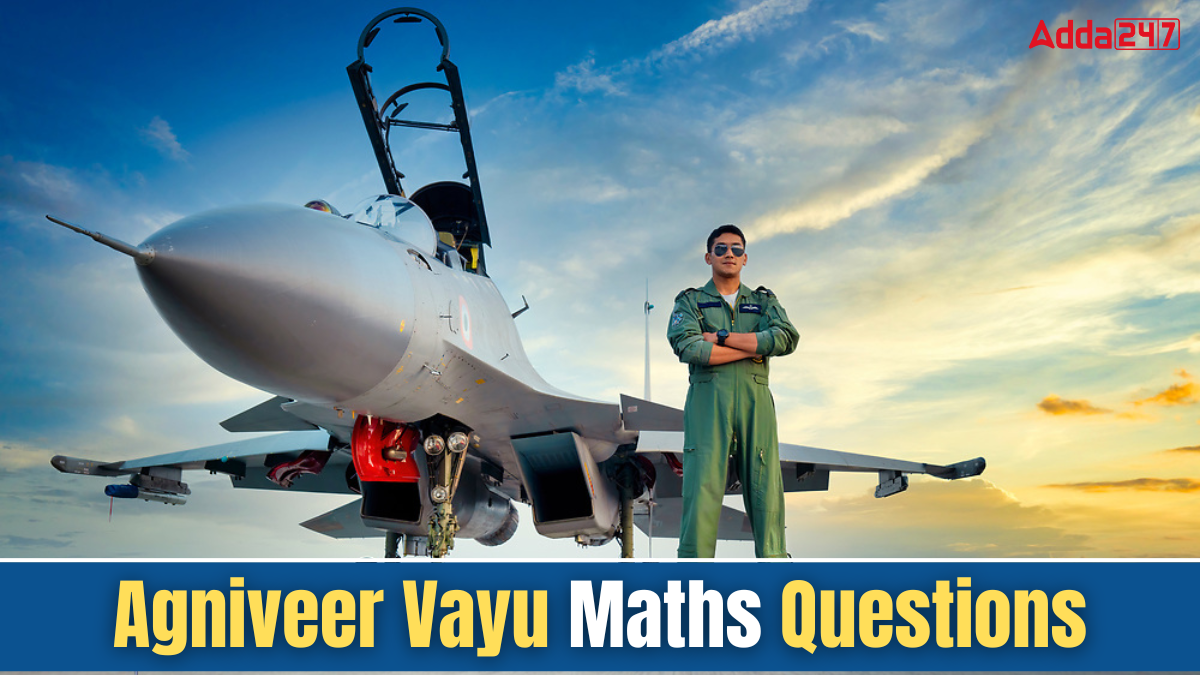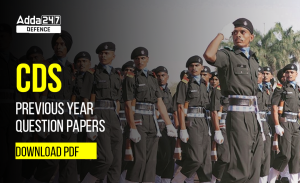To further improve the mathematical understanding of the candidates preparing for Agniveer Vayu exam, Defense Adda247 has prepared excellent MCQs on the topic of Profit and Loss. Agniveer Vayu Maths Questions are presented from a new and interesting perspective, so that you can understand the topic easily and strengthen your preparation. These MCQs will clear your concepts and boost your confidence, so that you can achieve success in the exam.
Agniveer Vayu Maths Questions
Mathematics can be an important and challenging subject in the Agniveer Vayu exam. In this article, we have brought to you some important questions related to profit and loss. Detailed solutions and answers are also provided with each question, so that you can not only solve the questions correctly, but also strengthen your mathematical skills. This will make your preparation more effective, and you will be able to excel in the exam.
Important MCQs of Profit & Loss for Agniveer Vayu
Q1. A man bought a number of oranges at 3 for a rupee and an equal number at 2 for a rupee. At what price per dozen, should he sell them to make a profit of 20%?
(a) Rs. 4
(b) Rs. 5
(c) Rs. 6
(d) Rs. 7
S1. Ans (c)
Sol.
Given: Equal number of oranges bought at 3 for a rupee and 2 for a rupee.
Formula: Selling Price = Cost Price × (1 + Profit%).
- Cost Price (CP) of 6 oranges bought at 3 for 1 rupee = 2 rupees.
- CP of 6 oranges bought at 2 for 1 rupee = 3 rupees.
- Total CP for 12 oranges = 2 + 3 = 5 rupees.
- To make a 20% profit, Selling Price (SP) = 5 × 1.20 = 6 rupees.
Correct Answer: (c) Rs. 6 per dozen
Q2. One saree was purchased for Rs. 564 after getting a discount of 6% and another saree was purchased for Rs. 396 after getting a discount of 1%. Taking both the items as a single transaction, what is the percentage of discount?
(a) 3.5
(b) 4
(c) 7
(d) 7.5
S2. Ans (b)
Sol.
Given:
- First saree after a 6% discount costs Rs. 564.
- Second saree after a 1% discount costs Rs. 396.
Formula:
Total Discount % = [(Total Marked Price – Total Selling Price) / Total Marked Price] × 100
- Marked Price (MP) of the first saree: Let it be x.
x – 0.06x = 564 → x = 600 - MP of the second saree: Let it be y.
y – 0.01y = 396 → y = 400 - Total MP = 600 + 400 = 1000
- Total Selling Price (SP) = 564 + 396 = 960
- Discount % = [(1000 – 960) / 1000] × 100 = 4%
Correct Answer: (b) 4%
Q3. A man sold two watches, each for Rs. 495. If he gained 10% on one watch and suffered a loss of 10% on the other, then what is the loss or gain percentage in the transaction ?
(a) 1% gain
(b) 1% loss
(c) 100/99% loss
(d) No gain no loss
S3. Ans (b)
Sol.
Given: Each watch was sold for Rs. 495. One was sold at 10% profit, the other at 10% loss.
Formula:
Total Loss = Total Cost Price – Total Selling Price
Loss % = (Total Loss / Total Cost Price) × 100
- SP of both watches = 495 + 495 = 990
- Cost Price (CP) of the first watch: 495 / 1.10 = 450
- CP of the second watch: 495 / 0.90 = 550
- Total CP = 450 + 550 = 1000
- Loss = 1000 – 990 = 10
- Loss % = (10 / 1000) × 100 = 1%
Correct Answer: (b) 1% loss
Q4. A fruit-seller buys lemons at 2 for a rupee and sells them at 5 for three rupees. What is his gain percent ?
(a) 10%
(b) 15%
(c) 20%
(d) 25%
S4. Ans (c)
Sol.
Given: Buys lemons at 2 for 1 rupee and sells at 5 for 3 rupees.
Formula:
Gain % = (Gain / Cost Price) × 100
- CP of 5 lemons = 2.5 rupees.
- SP of 5 lemons = 3 rupees.
- Gain = 3 – 2.5 = 0.5 rupees.
- Gain % = (0.5 / 2.5) × 100 = 20%
Correct Answer: (c) 20%
Q5. The merchant earns a profit of 20% by selling a basket containing 80 apples which cost Rs. 240. But he gives one-fourth of it to his friend at cost price and sells the remaining apples. In order to earn the same profit, at what price must he sell each apple?
(a) Rs. 3.00
(b) Rs. 3.60
(c) Rs. 3.80
(d) Rs. 4.80
S5. Ans (c)
Sol.
Given:
- 80 apples cost Rs. 240; one-fourth sold at cost price.
- Profit expected: 20%
Formula:
Profit % = (SP – CP) / CP × 100 - CP of 80 apples = 240
- Desired SP for 20% profit = 240 × 1.20 = 288
- Sold 20 apples at Rs. 3 each, earning 60 rupees.
- SP required from the remaining 60 apples = 228 rupees.
- Price per apple = 228 / 60 = 3.80
Correct Answer: (c) Rs. 3.80
Q6. A cloth store is offering “Buy 3, get 1 free”. What is the net percentage discount being offered by the store?
(a) 20%
(b) 25%
(c) 30%
(d) 40%
S6. Ans (b)
Sol.
Given: Buy 3, get 1 free.
Formula:
Net Discount % = (Free Items / Total Items) × 100
- Effective offer: Buy 4, pay for 3.
- Discount % = (1 / 4) × 100 = 25%
Correct Answer: (b) 25%
Q7. A person sold an article for Rs. 3,600 and got a profit of 20%. Had he sold the article for Rs. 3,150, how much profit would he have got?
(a) 4%
(b) 5%
(c) 6%
(d) 10%
S7. Ans (b)
Sol.
Given: Selling Price = Rs. 3600, 20% profit.
Formula:
SP = CP × (1 + Profit%)
Profit % = (Profit / CP) × 100
- CP = 3600 / 1.20 = 3000
- If sold at Rs. 3150, Profit = 3150 – 3000 = 150
- Profit % = (150 / 3000) × 100 = 5%
Correct Answer: (b) 5%
Q8. Two lots of onions with equal quantity, one costing Rs. 10 per kg and the other costing Rs. 15 per kg, are mixed together and whole lot is sold at Rs. 15 per kg. What is the profit or loss?
(a) 10% loss
(b) 10% profit
(c) 20% profit
(d) 20% loss
S8. Ans (c)
Sol.
Given: Equal quantities, cost Rs. 10 and Rs. 15 per kg, mixed and sold at Rs. 15 per kg.
Formula:
Profit % = (SP – CP) / CP × 100
- CP per kg = (10 + 15) / 2 = 12.50
- SP = 15 per kg
- Profit = 15 – 12.50 = 2.50
- Profit % = (2.50 / 12.50) × 100 = 20%
Correct Answer: (c) 20% profit
Q9. On a 20% discount sale, an article costs Rs. 596. What was the original price of the article?
(a) Rs. 720
(b) Rs. 735
(c) Rs. 745
(d) Rs. 775
S9. Ans (c)
Sol.
Given: After 20% discount, the price is Rs. 596.
Formula:
SP = MP × (1 – Discount%)
- Let MP = x
- 0.80x = 596
- x = 745
Correct Answer: (c) Rs. 745
Q10. When an article is sold at 20% discount, the selling price is Rs. 24. What will be the selling price when the discount is 30%?
(a) Rs. 25
(b) Rs. 23
(c) Rs. 21
(d) Rs. 20
S10. Ans (c)
Sol.
Given: 20% discount, SP = Rs. 24.
Formula:
MP = SP / (1 – Discount%)
- Let MP = x
- 0.80x = 24
- x = 30
For 30% discount:
New SP = 30 × 0.70 = Rs. 21
Correct Answer: (c) Rs. 21
Agniveer Vayu Profit & Loss Questions PDF
If you’re looking to access all the important questions on Profit and Loss in PDF format, you can download the Agniveer Vayu Maths Profit and Loss Questions PDF through the link provided below. Candidates can easily obtain it by clicking the link. This resource will enhance your preparation and help you master the topic effectively.




 AFCAT Eligibility Criteria and Age Limit...
AFCAT Eligibility Criteria and Age Limit...
 AFCAT Previous Year Papers, Download PDF
AFCAT Previous Year Papers, Download PDF
 CDS Previous Year Question Papers, Downl...
CDS Previous Year Question Papers, Downl...





